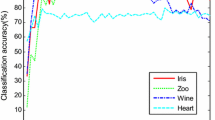Abstract
Adjusting parameters iteratively is a traditional way of training neural networks, and the Rough RBF Neural Networks (R-RBF-NN) follows the same idea. However, this idea has many disadvantages, for instance, the training accuracy and generalization accuracy etc. So how to change this condition is a hot topic in Academics. On the basis of Extreme Learning Machine (ELM), this paper proposes a Weighted Regularized Extreme Learning Machine (WRELM), taking into account both minimizing structured risk and weighted least-squares principle, to train R-RBF-NN. The traditional iterative training method is replaced by the minimal norm least-squares solution of general linear system. The method proposed in this paper, increasing controllability of the entire learning process and considering the structured risk and empirical risk, can improve the performance of learning and generalization. Experiments show that it can reach a very superior performance in both time and accuracy when WRELM trains the Rough RBF Neural Networks in pattern classification and function regression, especially in pattern classification, which can improve the generalization accuracy more than 3.36 % compared with ELM. Obviously, the performance of the method proposed in this paper is better than the traditional methods.






Similar content being viewed by others
Explore related subjects
Discover the latest articles, news and stories from top researchers in related subjects.References
Chiang J-H, Ho S-H (2008) A combination of rough-based feature selection and RBF neural network for classification using gene expression data. IEEE Trans Nanobioscience 7(1):91–99
Huang G-B, Zhu Q-Y, Siew C-K (2006) Extreme learning machine: theory and applica-tions. Neurocomputing 70(1–3):489–501
Zhang W, Qiu G (2005) Uncertain decision-making based on rough set. Tsinghua University Press, Beijing
Pawlak Z, Wong SKM, Ziarko W (1988) Rough sets: probabilistic versus deterministic approach. Int J of Man Mach Stud 29(1):81–95
Duntsch I, Gediga G (1998) Uncertainty measures of rough set prediction. Artif Intell 106(1):106–109
Chen H, Mao H (2010) A new method of weights allocation to case feature attributes based on rough set theory. J Xi’an Technolog Univ 30(4):402–404
Huang D (2003) Means of weights allocationwith multi-factors based on impersonal message entropy. Syst Eng Theory Methodol Appl 12(4):321–324
Cheng L, Hu J (2009) Matrix theory. China University of Mining and Technology Press, Xuzhou
Huang G-B, Siew C-K (2004) Extreme learning machine: RBF network case. Control Autom Robotics Vis Conf 2:1029–1036
Ding S, Qi B, Tan H (2011) An overview on theory and algorithm of support vector machines. J Univ Electron Sci Technol China 40(1):2–10
Deng W-Y, Zheng Q-H, Chen L, Xu X-B (2010) Research on extreme learning of neural networks. Chin J Comput 33(2):279–287
Deng N-Y, Tian Y-J (2004) A new method of data mining-support vector machine. Science Press, Beijing
Zhang X-G (2000) Introduction to statistical learning theory and support vector machines. Acta Autom Sin 26(1):32–42
Ding S, Jin F, Zhao X (2013) Modern data analysis and information pattern recognition. Science Press, Beijing
Suykens JAK, De Brabanter J, Lukas L, Vandewaile J (2002) Weighted least squares support vector machines: robustness and sparse approximation. Neurocomputing 48(1):85–105
Acknowledgments
This work is supported by the National Natural Science Foundation of China (No. 61379101), the National Key Basic Research Program of China (No. 2013CB329502), and the Opening Foundation of the Key Laboratory of Intelligent Information Processing of Chinese Academy of Sciences (No.IIP2010-1).
Author information
Authors and Affiliations
Corresponding author
Rights and permissions
About this article
Cite this article
Ding, S., Ma, G. & Shi, Z. A Rough RBF Neural Network Based on Weighted Regularized Extreme Learning Machine. Neural Process Lett 40, 245–260 (2014). https://doi.org/10.1007/s11063-013-9326-5
Published:
Issue Date:
DOI: https://doi.org/10.1007/s11063-013-9326-5




